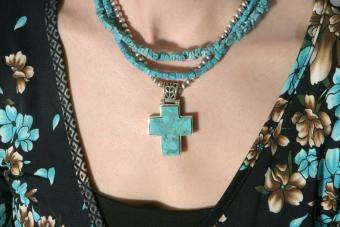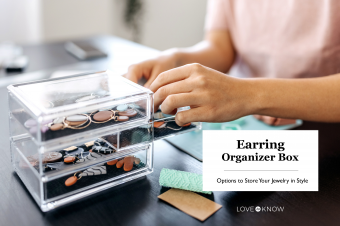
There are many stylish earring designs for men and women. An easy guide of what's available will help you choose the right designs for your collection.
Things to Consider When Buying Earrings
Both men and women should consider the shape of their faces when choosing earring designs. For example, if your face is oblong, then you don't want long earrings to emphasize the length of your face. Instead, you'll look better with round or hoop earrings. A good rule of thumb is to choose earrings that are the opposite shape of your face for better contrast, such as square shapes for a round face and vice versa. If your face is heart-shaped, then opt for earrings that are elongated and straight.
Common Earring Materials
Earrings can be made from inexpensive plastic, or the most expensive precious metals and jewels. You choose what you like and can afford.
Suitable metals include:
- Surgical stainless steel - Hypo-allergenic and strong
- 14-18K Gold - Hypo-allergenic and beautiful
- Titanium - Extremely durable, but tends to irritate fresh piercings
Less desirable materials include:
- Gold-plated or silver-plated are a thin layer of metal over steel and tends to tarnish and wear away.
- Sterling is not a good choice for pierced style earrings, since it reacts with body fluids and can leave permanent dark blackish-green marks on your lobes or cause infections due to its oxidation properties.
- Nickel is an inexpensive metal and will cause a red, moist rash wherever it comes in contact with your lobes. Although some people are immune to it, its use is ill advised.
Earring Designs Great for Men & Women
Whether you're a man or woman, you can enjoy a collection of different earrings to change out with your outfits. When shopping for earrings, it helps to imagine the outfit you want to match.
Clip On
These earbobs attach to your lobe with a spring-loaded back that opens to put over the lobe, and then the back hinge latches closed to secure the earring to the lobe. Although earrings of this type can look just as nice as pierced ones, clips are known to slip, and many a bob has been lost this way. The clip back earring is a style for anyone without ear piercings, although you can always wear them if you have ear piercings.

Ear Cuff
An ear cuff comes in all types of designs, from the simplest one that fits over the upper curve of your ear, to a hooping cuff that fits in the lower inside part of your ear.
Earwire, Fishing Hook
The earwire is sometimes referred to as hook earring since it resembles a shepherd hook, or fishing hook. This earring is bowed and slips through your ear piercing. The earwire is secured to the front decorative part of the earring finding that weights the wire. The looped/bowed part is in the center of your ear piercing with the back of the earwire dangling behind your ear acting as a counter-weight.
French Clip
A French clip earring is a post earring that has a wire clip that latches on the lobe to secure the post, instead of sized slip-on clip.

Latch Earrings
A latch back features a hinged backing. There are several designs for the backs that snap shut in the back of the earring. Some have a lever that you pinch shut.
Magnetic
Magnetic earrings are an option for anyone without pierced ears. If you have pierced ears, you can still wear this design. The two components of this type of earring locks together from the front and back, but the magnets are typically strong enough to be painful to wear.
Post
The face of the jewelry sets on a thin post that passes through the ear piercing, The post is secured in place with a small slide-on clip in the back of your ear.
Push or Butterfly
A push back is secured with a butterfly back. This design is a disc that features tabs on each side that are curled into each other. The space between the curls has a spring action that clutches the post when its threaded through the disc and holds the earring securely in place.
Screw On
A screw back earring is an old-fashioned earring that features a grooved post. The earring is secured by screwing the backing onto the post until it is tightened and secure.
Favorite Types of Earrings
There are several types of earrings that are all-time favorites. You may have many pairs of one type or a wide variety of types with various backings.
Barbells
Barbell earrings are a favored choice for body piercings. Most barbells worn on the ear are long and are used on the top of the ear. The bar travels from an outer piercing to an inner one for a vertical style piercing on your ear.
Dangle
This style attaches to your lobe with a post, earwire, or other design, so the front dangles freely. You can always use a dangle, such as a charm on a hoop earring. Dangling earring styles are often earwire designs.
Hoops
Hoops come in all sizes and all materials. From tiny hoops to large ones that look as though they could double as bracelets. Hoops typically attach with a small wire that passes through your piercing and connects to an opening in the rear portion of the hoop. Other hoops use a post attachment and only give the illusion of being a complete ring.
Some hoop designs feature more than one hoop or a series of different sizes of hoops. You want to pay close attention to the weight of larger earring hoops since they can pull your earlobe down, stretching it when that isn't your intention.

Novelty
A novelty earring can be any type of cute or silly design, such as figurines, gothic skull and bones, hearts, holiday designs, such as Santa, Christmas tree, pumpkins, and more.
Studs
A stud is the typical earring style for when you get your ears pierced. Studs are hypoallergenic and should be left in your ear for eight weeks, so your ear heals around the post, creating a permanent piercing. Once your piercing has healed, you can change out the earrings. Studs are great choices for low-profile earrings. Some popular stud earrings include pearls, diamonds, gemstones, beads, and discs.

Earrings to Stretch Piercings
You may be interested in stretching your ear piercings for a more personalized look. Both men and women chose this option when they are looking for something more in their earring style. Most of these stretch styles can be found as fakes that are a great way to try out the look before committing. Once your earlobe is stretched, it is difficult for it to close up (much depends on your body's healing ability).
- Go up only one gauge size when stretching.
- Wait 2-6 months before attempting to use a large gauge.
- If you plan to allow your piercing to close up, don't go up more than 2 - 0 gauge.

What Are Earring Gauge Sizes?
The bar thickness (part that goes through the piercing) is measured by the gauge size. The gauge size is what determines the size of your piercing hole. The highest numbers like 16 or 14 are the thinnest bars, and the lower numbers like 6 or 4 are the thickest bars and make bigger holes.
Most piercings are made with 18 or 16 gauge bars. The next size you'd use to gradually increase the piercing hole would be a 14 gauge bar. To avoid creating scar tissue or an injury to your ear, you want to slowly increase the size of the bar every 2-6 months. How often you increase the gauge depends on your individual body and how it repairs itself.
- Tunnels (cylinder shape) or round plugs can be inserted to stretch your piercing hole.
- Tapers are plugs that taper into a point and are used for larger stretching.
- Never use a silicone plug, tunnel, or taper since material collect bacteria and will create an infection, or worse create scar tissues that can lead to a blowout!
How to Find the Perfect Earrings
Everyone wants for the perfect pair of earrings to go with their wardrobe. When you have an earring guide to designs for men and women, making a decision about the type of earrings you want is easier.







